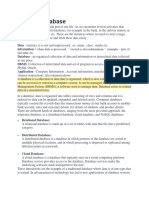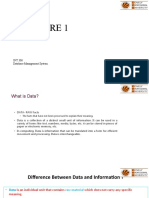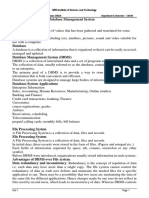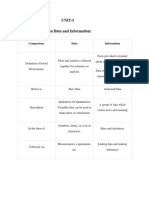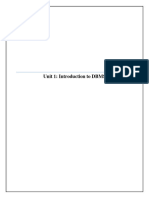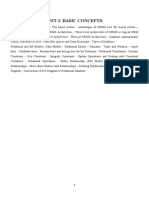0 ratings0% found this document useful (0 votes)
40 views21 pagesDbms Unit 1 Notes
this is the notes of dbms
Uploaded by
shivani123409Copyright
© © All Rights Reserved
We take content rights seriously. If you suspect this is your content, claim it here.
Available Formats
Download as PDF or read online on Scribd
0 ratings0% found this document useful (0 votes)
40 views21 pagesDbms Unit 1 Notes
this is the notes of dbms
Uploaded by
shivani123409Copyright
© © All Rights Reserved
We take content rights seriously. If you suspect this is your content, claim it here.
Available Formats
Download as PDF or read online on Scribd
You are on page 1/ 21
©) studocu
UNIT 1 - DBMS - Unit 1 notes
UNIT-1
Data: - Data is raw, unorganized facts that need to be processed. Data we mean
known facts or figures that can be recorded. Data can be represented in alphabets,
digits and special characters.
Information: - Information is organized or classified data, which has some
meaningful values for the receiver. Information is the processed data on which
decisions and actions are based.
Database:-The collection of data, usually referred to as the database, contains
information relevant to an enterprise. A database is an organized collection of data,
generally stored and accessed electronically from a computer system. A database is
a collection of related data. By data, we mean known facts that can be recorded and
that have implicit meaning. For example: The college Database organizes the data
about the admin, staff, students and faculty etc
> A database management system (DBMS) is a collection of programs that
enables users to create and maintain a database.
Users/ Programmers
Database
System ee
[Application Proprame/Gueres
DBMS. v
Sata ‘Software to Process
(Queries/Programs
ft
‘Software to Accass
‘Stored Data
Stored Database
Datinition
(Meta-Data)
Database System Environment
This documents abe raw of charge on © studocu
Downloaded by Shivani Kumar (shivani122409@gmal.com)
> The DBMS is a general-purpose software system that facilitates the
processes of defining, constructing, manipulating, and sharing databases
among various users and applications.
> A database is a collection of interrelated data and a set of programs to
access those data.
> The primary goal of a DBMS is to provide a way to store and retrieve
database information that is both convenient and efficient.
Database systems are designed to manage large bodies of information
Management of data involves both defining structures for storage of
information and providing mechanisms for the manipulation of information.
In addition, the database system must ensure the safety of the information
stored, despite system crashes or attempts at unauthorized access.
For example : MY SQL, Oracle, Microsoft SQL Server, PostgreSQL,
MongoDB, dBase,IBM Db2,SQL Lite,MariaDB,FoxPro,Sybase
v
v
v
File Management System versus Database System.
File-based approaches which came into being with the first commercial
applications of computers suffered from the following significant disadvantages:
1. Data Redundancy: Data Redundancy means same information is duplicated
in several files. This makes data redundancy.
2. Data consistency: Data consistency refers to whether the same data kept at
different places do or do not match.
3. Difficulty in Accessing Data: It is not easy to retrieve information using a
conventional file processing system. Convenient and efficient information
retrieval is almost impossible using conventional file processing system.
4, Data Isolation: Data are scattered in various files, and the files may be in
different format, writing new application program to retrieve data is
difficult.
5. Integrity Problems: The data values may need to satisfy some integrity
constraints. For example, the balance field value must be greater than 5000.
We have to handle this through program code in file processing systems. But
in database we can declare the integrity constraints along with definition
itself.
6. Atomicity Problem: It is difficult to ensure atomicity in file processing
system. For example, transferring 100 Rs. From account A to account B. If a
failure occurs during execution there could be situation like 100 Rs. is
deducted from account A and not credited in account B.
Downloaded by Shivani Kumar (shivani128409@gmal.com)
7. Concurrent Access anomalies: If multiple users are updating the same data
simultaneously it will result in inconsistent data state. In file processing
system, it is very difficult to handle this using program code. This results in
concurrent access anomalies.
8. Security Problems: Enforcing security constraints in file processing system
is very difficult as the application programs are added to the system in an
adhoc manner.
Difference between File Proce:
sing System VS DBMS.
File Processing System
DBMS
File system is a software that manages and
organizes the files in a storage medium
within a computer.
DBMS is a software for managing the
database.
Redundant data can be present in a file
system.
In DBMS there is no redundant data.
It doesn’t provide backup and recovery of
data if it is lost.
It provides backup and recovery of data
even if it is lost.
There is no efficient query processing in
file system,
Efficient query processing is there in
DBMS
There is less data consistency in the file
system.
There is more data consistency because of
the process of normalization.
It is less complex as compared to DBMS.
It has more complexity in handling as
compared to the file system.
File systems provide less
comparison to DBMS
security in
DBMS has more security mechanisms as
compared to file systems
Tris less expensive than DBMS.
Tt has a comparatively higher cost than a
file system,
There is no data independence
In DBMS data independence exists.
The file system docsnt have a crash
mechanism,
DBMS provides a crash recovery
mechanism
For Example- Cobol, C++
For Example- Oracle, SQL Server
Database-System Appl
Databases are widely used. Here are some representative applications:
Enterprise Information
Sales: For customer, product, and purchase information.
Accounting: For payments, receipts, account balances, assets and otheraccounting
information.
This documents abe raw of charge on © studocu
Downloaded by Shivani Kumar (shivani122409@gmal.com)
+ Human resources: For information about employees, salaries, payroll taxes,and
benefits, and for generation of paychecks.
eManufacturing: For management of the supply chain and for tracking
productionof items in factories, inventories of items in warehouses and stores,and
orders for items.
Online retailers: For sales data noted above plus online order tracking, generation
of recommendation lists, and maintenance of online productevaluations,
Banking and Finance
Banking: For customer information, accounts, loans, and banking transactions.
° Credit card transactions: For purchases on credit cards and generation ofmonthly
Jatements.
¢ Finance: For storing information about holdings, sales, and purchases offinancial
instruments such as stocks and bonds; also for storing real-timemarket data to
enable online trading by customers and automated tradingby the firm.
Universities: For student information, course registrations, and grades (inaddition
to standard enterprise information such as human resources andaccounting).
Airlines: For reservations and schedule information. Airlines were among thefirst
to use databases in a geographically distributed manner.
Telecommunication: For keeping records of calls made, generating monthlybills,
maintaining balances on prepaid calling cards, and storing informationabout the
communication networks.
Characte 's of database approacl
A number of characteristics distinguish the database approach from the much older
approach of programming with files.The main characteristics of the database
approach versus the file-processing approach are the following
© Self-describing nature of a database system
© Insulation between programs and data, and data abstraction
© Support of multiple views of the data
© Sharing of data and multiuser transaction processing
1, Self-describing nature of a database system: A fundamental characteristic of
the database approach is that the database system contains not only the database
itself but also a complete definition or description of the database structure and
constraints. This definition is stored in the DBMS catalog, which contains
information such as the structure of each file, the type and storage format of each
data item, and various constraints on the data. The information stored in the catalog
is called meta-data, and it describes the structure of the primary database.
Downloaded by Shivani Kumar (shivani128409@gmal.com)
2. Insulation between programs and data, and data abstraction: In traditional
file processing, the structure of data files is embedded in the application programs,
so any changes to the structure of a file may require changing all programs that
access that file. By contrast, DBMS access programs do not require such changes
in most cases. The structure of data files is stored in the DBMS catalog separately
from the access programs. This property is called program-data independence.
3. Support of multiple views of the data: A database typically has many users,
each of whom may require a different perspective or view of the database. A view
may be a subset of the database or it may contain virtual data that is derived from
the database files but is not explicitly stored. Some users may not need to be aware
of whether the data they refer to is stored or derived. A multiuser DBMS whose
users have a variety of distinct applications must provide facilities for defining
multiple views.
4. Sharing of data and multiuser transaction processing: A multiuser DBMS, as
its name implies, must allow multiple users to access the database at the same time.
‘This is essential if data for multiple applications is to be integrated and maintained
in a single database. The DBMS must include concurrency control software to
ensure that several users trying to update the same data do so in a controlled
manner so that the result of the updates is correct.
Advantages of DBMS:
1. Controlling Data Redundancy,
In file systems each application program has its own private files. In this case, the
duplicated copies of the same data are created in many places. In DBMS, all data
of an organization is integrated into a single database file. The data is recorded in
only one place in the database and it is not duplicated,
2, Sharing of Data
In DBMS, data can be shared by authorized users of the organization. The database
administrator manages the data and gives rights to users to access the data. Many
users can be authorized to access the same piece of information simultaneously.
The remote users can also share same data. Similarly, the data of same database
can be shared between different application programs.
This documents abe raw of charge on © studocu
Downloaded by Shivani Kumar (shivani122409@gmal.com)
3. Data consistency
By controlling the data redundancy, the data consistency is obtained. If a data item
appears only once, any update to its value has to be performed only once and the
updated value is immediately available to all users. If the DBMS has controlled
redundancy, the database system enforces consistency.
4. Proper data integration
In Database management system, data in database is stored in tables. A single
database contains multiple tables and relationships can be created between tables
(or associated data entities). This makes easy to retrieve and update dat
5. Enforcing Integrity Constraints
Integrity constraints or consistency rules can be applied to database so that the
correct data can be entered into database. The constraints may be applied to data
item within a single record or may be applied to relationships between records.
6.Data Security
DBMS makes it easier to enforce security restriction since the data is stored
centrally. DBMS provides security tools as username and password.
7. Restricting Unauthorized Access
When multiple users share a large database, it is likely that most users will not
beauthorized to access all information in the database
8. Providing Storage Structures and Search Techniques for Efficient Query
Processing
Database systems must provide capabilities for efficiently executing queries and
updates. Because the database is typically stored on disk, the DBMS must provide
specialized data structures and search techniques to speed up disk search for the
desired records
9. Providing Multiple User Interfaces
Because many types of users with varying levels of technical knowledge use a
database, a DBMS should provide a variety of user interfaces. These include apps
formobile users, query languages for casual users, programming language
interfaces
Downloaded by Shivani Kumar (shivani128409@gmal.com)
Disadvantages of DBMS
‘There are some following disadvantages of the database management system,
1. High Cost
The high cost of software and hardware is the main disadvantage of the database
management system. Database users require a high-speed processor and huge
memory size to use the database on the DBMS.
2. Huge Size
The size of the database is not big at the initial state, but when the user stores a
large amount of data, then it creates many problems. Due to the huge data,
database systems do not provide good results and do not run efficiently. That's
why the size is another limitation of the database systems.
3. Database Failure
In the database systems, all the data or information of an organization is stored in
one centralized database. If the database of that organization fails, then the data is
lost, and the organization will collapse. So, database failure is a big problem with
the database management system.
4. Complexity
Database management system (DBMS) is so complex for non-technical users. So,
it isn’t easy to manage and maintain database systems, Therefore, training for the
designers, users, and administrators is necessary to efficiently run the database
systems.
Schemas in DBMS
Databases change over time as information is inserted and deleted.
The collection of information stored in the database at_a particular moment is
called an instance of the database.
‘The overall design of the database is called the database schema.
Schemas are changed infrequently, if at all. The concept of database schemas and
instances can be understood by analogy to a program written in a programming
language.
A database schema corresponds to the variable declarations (along with associated
type definitions) in a program Each variable has a particular value at a given
instant. The values of the variables in a program at a point in time correspond to an
instance of a database schema.
Database systems have several schemas, partitioned according to the levels of
abstraction.
This documents abe raw of charge on © studocu
Downloaded by Shivani Kumar (shivani122409@gmal.com)
‘Types of Schemas
1) Physical schema :- The physical schema describes the database design at
the physical level,
2) Logical schema: - the logical schema describes the database design at the
logical level.
3) Internal schema:-A database may also have several schemas at the view
levelthat describe different views of the database.
‘The goal of the three-schema architecture is to separate the user applications from
the physical database.In this architecture, schemas can be defined at the following
three levels:
1. Internal level or physical level-The internal level has an internal schema,
which describes the physical storage structure of the database. The internal
schema uses a physical data model and describes the complete details of data
storage and access paths for the database
Downloaded by Shivani Kumar
vani123408@gmal.com)
a End Users -
External Level ea cee ed
View View
Exteral/Conceptual
Mapping
Conceptual Level Conceptual Schema
Conceptual/intemal ‘
Mapping
pring t
Intemal Level Internal Schema
Stored Database
2. Conceptual level -The conceptual level has a conceptual schema, which
describes the structure of the whole database for a community of users. The
conceptual schema hides the details of physical storage structures and
concentrates on describing entities, data types, relationships, user operations,
and constraints. Usually, a representational data model is used to describe
the conceptual schema when a database system is implemented. This
implementation conceptual schema is often based on a conceptual schema
design in a high-level data model.
3. External level or View level -The external or view level includes a number
of external schemas or user views. Each external schema describes the part
of the database that a particular user group is interested in and hides the rest
of the database from that user group. As in the previous level, each external
schema is typically implemented using a representational data model,
possibly based on an external schema design in a high-level data model.
This documents abe raw of charge on © studocu
Downloaded by Shivani Kumar (shivani122409@gmal.com)
Data independence
Data independence can be defined as the capacity to change the schema at one
level of a database system without having to change the schema at the next
higher level. We can define two types of data independence:
1. Logical data independence - Logical data independence is the capacity
to change the conceptual schema without having to change external
schemas or application programs. We may change the conceptual schema
to expand the database (by adding a record type or data item), to change
constraints, or to reduce the database(by removing a record type or data
item).In the last case, external schemas that refer only to the remaining
data should not be affected. Only the view definition and the mappings
need to be changed in a DBMS that supports logical data independence.
2. Physical _data_independence - Physical data independence is the
capacity to change the internal schema without having to change the
conceptual schema. Hence, the external schemas need not be changed as
well. Changes to the internal schema may be needed because some
physical files were reorganized—for example, by creating additional
access structures—to improve the performance of retrieval or update. If
the same data as before remains in the database, we should not have to
change the conceptual schema.
External level
Logical Data Independence
Logical level
Physical Date Independence
Physical level
Stored Database
Downloaded by Shivani Kumar (shivani128409@gmal.com)
Difference between Logical and physical data Independence
Logical Data Independence
Physical Data Independence
Logical Data Independence is mainly
concerned with the structure or changing
the data definition.
Mainly concerned with the storage of the
data.
It is difficult as the retrieving of data is
mainly dependent on the logical structure
of data
It is easy to retrieve.
it is difficult to achieve logical data]it is easy to achieve physical data
independence. independence
You need to make changes in the | A change in the physical level usually does
Application program if new fields are
added or deleted from the database.
not need change at the Application program
level.
Concerned with conceptual schema
Concerned with internal schema
Example: new
attribute
Add/Modify/Delete a
Example:
techniques,
devices, etc
change in compression
hashing algorithms, storage
Database Adi
The DBA is responsible for authorizing acces
jistrators
to the database, coordinating and
monitoring its use, and acquiring software and hardware resources as needed. The
DBA is accountable for problems such as security breaches and poor system
response time. DBA has the central control over the system. The function role of
the DBA include:
* Schema Definition: The DBA creates the original database schema by a set
of data definition statements in the DDL.
* Storage structure and access-method d nm: DBA decides what
structure to be used to store the data and what method to be used to access
that.
* Schema and physical-organization modification: According to the need of
the organization the DBA carries out changes to the schema and physical
organization to improve the performance.
* Granting of authorization for data access: The DBA administrator
decides which user will access which part of the database
This documents abe raw of charge on © studocu
Downloaded by Shivani Kumar (shivani122409@gmal.com)
+ Routine maintenance: DBA does some of the routine maintenance like
periodically backing up the database, ensure that enough free disk space
available for normal operations, monitors jobs running on the database etc.
Database Languages
A database system provides a data definition language, which specifies the
database schema, and a data manipulation language, which expresses database
queries and updates.
1. Data-Definition Language (DDL): DDL is used to define the conceptual
schema of the database. It is a set of SQL command used to create, modify and
delete database structures but not data. These commands are normally not used
by a general user, who should be accessing the database via an application.
They are generally used by the DBA
A data dictionary contains metadata i.e. data about data. The schema of table is
an example of metadata. A database system consults the data dictionary before
reading or modifying actual data.
2. Data-Manipulation Language (DML): Data manipulation includes retrieval
of data stored in database, insertion of new data into the database, deletion of
data from the database and modification of data stored in the database.
Data manipulation language enables users to access or manipulate data as
organized by different data model
DMLs are of two types:
Y Procedural DML: It requires a user to specify what data are needed and how
to get those data.
¥ Nonprocedural DML: It requires a user to specify what data are needed
without specifying how to get those data.
Database Users
Depending on different type of uses, there are different types of users and for each
type of user different types of interfaces have been designed.
* Naive users / Parametric users: There are unsophisticated users who
interact with the system by invoking one of the application programs that
have been written previously. They also read reports from the database,
Example: bank teller, a person checking his balance through internet
© Application Programmers: These are computer professionals who write
application programs to develop user interfaces. Using Rapid application
Downloaded by Shivani Kumar
vani123408@gmal.com)
development (RAD) tool application programmers construct forms and
reports rapidly without writing programs.
Sophisticated Users: These users interact with the system without writing
programs. They from their requests in a database query language and
submit it to the query processor. Examples: engineers, scientists, business
analytical processing (OLAP), Data mining that views them the
summarized data in different ways.
Casual End Users: These users occasionally access the database, but they
may need different information each time. They use a sophisticated
database query language to specify their requests and are typically middle
or high-level managers or other occasional browsers.
Database designers arc responsible for identifying the data to be stored in
the database and for choosing appropriate structures to represent and store
this data.
System Analyst: System Analyst is a user who analyzes the requirements
of parametric end users. They check whether all the requirements of end
users are satisfied.
Specialized users are sophisticated users who write specialized database
applications that do not fit into the traditional data-processing framework
Among these applications are computer-aided design systems, knowledge-
base and expert systems
This documents abe raw of charge on © studocu
Downloaded by Shivani Kumar (shivani122409@gmal.com)
Overall Database Structure
A DBMS is a complex software system.
=z =a
ectensamen,| [ septenton | [Puce "| ( csupee
‘web-users) Lenie gies (analysts)
‘Spplication C application query Sdminiswaion
interfaces ‘programs, tools tools
_—_ ra | eae] |ooomeenes|
ee
Se ee a
as ——
object code and organizer
query evaluation
engine
Tae authorization
= ‘and integrity manager
manager
iierinekd bascracwicssiec
storage manager
disk storage
data dictionary
al data
data Lf
Some common components of DBMS are as below:
1. Storage manager: A Storage manager is a program module, which provides
the interface between the low-level data stored in the database and the
application programs and queries submitted to the system. It is responsible
for interfacing with file system.
Downloaded by Shivani Kumar (shivani128409@gmal.com)
y
The storage manager components include:
Authorization and integrity manager, which tests for the satisfaction
of integrity constraints and checks the authority of users to access data.
Transaction manager, which ensures that the database remains in a
consistent (correct) state despite system failures, and that concurrent
transaction executions proceed without conflicting.
File manager, which manages the allocation of space on disk storage
and the data structures used to represent information stored on disk.
Buffer manager, which is responsible for fetching data from disk
storage into main memory, and deciding what data to cache in main
memory.
Query Processor: Query processor translates statements in a query
language into low-level instructions the database manager understands.
The query processor components include
DDL interpreter, which interprets DDL statements and records the
definitions in the data dictionary.
DML compiler, which translates DML statements in a query language
into an evaluation plan consisting of low-level instructions that the query
evaluation engine understands
Data Files: Store the database itself.
Data dictionary: Stores information about the structure of the database. It is
used heavily. Great emphasis should be placed on developing a good design
and efficient implementation of the dictionary.
This documents abe raw of charge on © studocu
Downloaded by Shivani Kumar (shivani122409@gmal.com)
DATA MODEL
1. Hierarchical Data Model:The hierarchical database is the oldest form of
database, This data model organizes the data in a tree like structure, The data are
stored as records which are connected to one another through links. The
hierarchical database model mandates that cach child record has only one
parent, whereas each parent record can have one or more child records. In this data
model uses parent child relationship with one-to-many ( 1:M) relationship.
© Tivall Tera
cut
ha
ys,
Oo0o i] [Lead] [a] [Leal
chs | Lowe | [owe | oud
Desartment| Infrastnacture
a = | =
———
= aa]
Advantages of Hierarchical data Model
+ Promotes data sharing.
+ Conceptual Simplicity.
+ Data security
+ Data independence.
+ Efficiency with one-to-many relationship.
Disadvantages of Hierarchical data Model
+ Requires knowledge of physical storage
+ Difficult to manage and lack of standards
+ Complex implementation
Downloaded by Shivani Kumar (shivani128409@gmal.com)
lodel:A network databases are mainly used on a large digital
computer. It more connections can be made between different types of data. The
network data model expands the hierarchical data model by providing multiple
paths among segments. The difference between each child or member can have
more than one parent. In this model allows one-to-one(1:1) ,one-to-many(1:M) and
many-to-many (M:M) relationship.
- SSS
Wiathematies }< Com puter
Department Sse Department |
aa oS sb
} Library Computer Lab
Figure 2 6 Network date model forthe ‘Unieersity' system
‘Advantages: The major advantages of network model are —
1. Conceptual simplicity-Just like the hierarchical model,the network model is
also conceptually simple and easy to design
2. Handles more relationship types-The network model can handle the one to
many and many to many relationships which is real help in modeling the
real-life situations.
3. Ease of data access-The data access is easier and flexible than the
hierarchical model.
‘his documents avaiable roe charge on © studocu
Downloaded by Shivani Kumar (shivani122409@gmal.com)
4. Data integrity- The network model does not allow a member to exist
without an owner.
5. Data Independence
Disadvantages: The disadvantages of network model are —
1. System complexity- All the records are maintained using pointers and hence
the whole database structure becomes very complex.
2.
very difficult.
Lack of structural independence- Structural changes to the database is
3. Relational Model The relational model uses a collection of tables to represent
both data and the relationships among those data. Each table has multiple columns,
and each column has a unique name. Tables are also known as relations. The
relational model is an example of a record-based model. Record-based models are
so named because the database is structured in fixed-format records of several
types. Each table contains records of a particular type. Each record type defines a
fixed number of fields, or attributes. The columns of the table correspond to the
attributes of the record type. The relational data model is the most widely used data
model,
Tobte
datgibutes
Coins) C wame Gass [siarks Age
e Anoop 10 30 2
Ee = | Anweg | G0 |a2| | 2 f
2 Ganesh 10 aa Fa
*
column
Advantages of Relational data model
+ Structured independence
+ Tabular view improves simplicity.
+ Support large amounts of data.
+ Improved Conceptual Simplicity
tL setucteyrci
Downloaded by Shivani Kumar
vani123408@gmal.com)
+ Powerful database management system
Disadvantages of Relational data model
+ Hardware and system software overhead
+ People need training if they want to use the system effectively and
efficiently.
+ Poor design and implementation
4. Object-Oriented Data ModelIn Object Oriented Data Model, data and their
relationships are contained in a single structure which is referred as object in this
data model. In this, real world problems are represented as objects with different
attributes.It is extension of E-R model with additional features of encapsulation,
object, methods and polymorphism. The object-relational data model combines
features of the object-oriented data model and relational data model.
Advantages of Object Oriented data Model
1. Semantic content is added
2. Visual presentation includes semantic content
3. Modularity
4. Reusability
5. Inheritance promotes data sharing
Disadvantages of Object Oriented data Model
‘This document is avaiable fre of charge on
Downloaded by Shivani Kumari (shivani123409@gmal.com)
1. Slow of development of standards
2. Complex navigational data access
3. High system overhead slows transactions
5, Entity-Relationship Model The entity-relationship (E-R) data model uses a
collection of basic objects, called entities, and relationships among these objects.
An entity is a “thing” or “object” in the real world that is distinguishable from
other objects. The entity-relationship model is widely used in database design
Advantages of ER model in DBMS.
1. Conceptual simplicity
2. Visual representation
3. Effective communication tool
4. Integrated with the relational database model
Disadvantages of ER Model in DBMS
1. Limited constraint representation
2. Limited relationship representation
3. No data manipulation language
4. Loss of information content
Downloaded by Shivani Kumar (shivani128409@gmal.com)
You might also like
- Module1-Database System Concept and ArchitectureNo ratings yetModule1-Database System Concept and Architecture62 pages
- Chapter 1 Introduction To Database SystemsNo ratings yetChapter 1 Introduction To Database Systems36 pages
- IT 405 (DBMS) Unit I Notes - 1615635798No ratings yetIT 405 (DBMS) Unit I Notes - 161563579815 pages
- 23acs12 Dbms Complete Notes Unit I To VNo ratings yet23acs12 Dbms Complete Notes Unit I To V124 pages
- Unit-I Comparison Between Data and InformationNo ratings yetUnit-I Comparison Between Data and Information9 pages
- DBMS vs File System: Key Concepts & AdvantagesNo ratings yetDBMS vs File System: Key Concepts & Advantages98 pages
- RDBMS For BCOM 6th (Old) and 3rd (New) Sem80% (5)RDBMS For BCOM 6th (Old) and 3rd (New) Sem110 pages
- Introduction To Database Management System-NotesNo ratings yetIntroduction To Database Management System-Notes46 pages
- Database Management Systems (DBMS) Course-KCS-501: Lec 1 - R. S. KohliNo ratings yetDatabase Management Systems (DBMS) Course-KCS-501: Lec 1 - R. S. Kohli13 pages
- 22CS4201 DBMS UNIT 1 - NotesbbhjsjsjjsnsnsNo ratings yet22CS4201 DBMS UNIT 1 - Notesbbhjsjsjjsnsns42 pages




